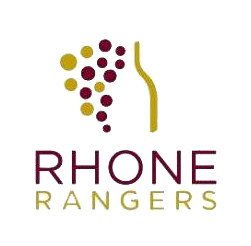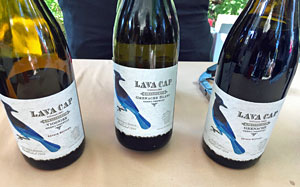Acquiesce Winery
 |
| Sue Tipton and Christina Lopez |
Located in Lodi, Acquiesce was established in 2012 by owner/winemaker Sue Tipton and her husband Rodney. Acquiesce is unique in the Lodi region in that they produce only white and rosé wines. Their estate vineyard was first planted in 2008 and now includes ten acres of various white Rhône Valley grape varieties. All the wines are from estate-grown fruit and are made entirely in temperature-controlled stainless steel tanks. Sue, Rodney, and assistant winemaker Christina Lopez were all on hand at the tasting. Their new 2021 Méthode Champenoise Sparkling Picpoul Blanc displayed subtle apple and pear aromas, lemonpeel, and a mild yeasty note, with fine bubbles and a crisp, clean finish. The 2021 Bourboulenc – one of the lesser-known white Rhône varieties – had a bright lemon character with floral undertones, medium body, and a long tasty finish. The 2021 “Belle Blanc” is a blend of 30% Roussanne, 30% Grenache Blanc, and 20% Bourboulenc – this featured more earthy pear and stone fruit aromas with touches of fresh herbs and tropical fruit, with a richer mouthfeel and a lively finish.
Bonny Doon Vineyard
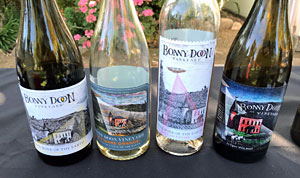 |
One of California’s early “Rhone Rangers,” Randall Grahm of Bonny Doon Vineyard made his first vintage of their flagship “Le Cigare Volant” Rhône blend in 1984. Randall continues to head up the Bonny Doon winemaking team, and Nicole Walsh is the longtime associate winemaker. I spotted Randall at the tasting though he wasn’t behind the winery table when I got there late in the afternoon. Bonny Doon poured four different “Cigare” renditions – Blanc, Orange, Vin Gris, and the original red version – and I managed to taste all four just before time ran out on the tasting, with two being particular favorites. The 2022 “Le Cigare Orange” is 52% Grenache Blanc, 42% Grenache Gris, 6% Orange Muscat and was fermented on the skins for about 8-10 days. This had floral, stone fruit, and orangepeel aromas with medium body and a bright finish. The 2021 “Le Cigare Volant” – 65% Grenache, 18% Syrah, 15% Cinsault, 2% Petite Sirah – displayed red fruits, earth, and spice on the nose, with medium weight and good structure.
Cline Family Cellars
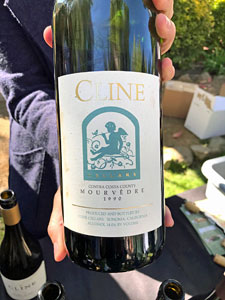 |
Fred and Nancy Cline founded Cline Cellars in 1982, and they moved the winery from Oakley to the Carneros region in 1991. The winery continues to work with fruit from Contra Costa County as well as from their vineyards in Carneros and the Petaluma Gap. Tom Gendall is the director of winemaking and viticulture, and Katie Hoggins is the winemaker. Fred received this year’s Rhone Rangers Lifetime Achievement Award following the afternoon tasting. I particularly enjoyed the 2022 J. Poppe Vineyard Grenache Gris from Carneros – this is actually a vin gris of Grenache, and featured bright red fruit, stone fruit, and floral aromas with a nice texture and lively finish. I tasted two older library wines at the Cline table. The 1990 Mourvèdre had lots of earth and spice notes along with subtle plummy fruit, and still displayed firm tannins. The 2009 “Small Berry” Mourvèdre had brighter red berry aromas along with spice and pleasant smoky undertones, with a nice texture and finish.
Holly’s Hill Vineyards
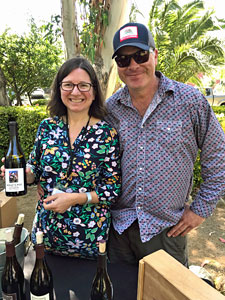 |
| Carrie & Josh Bendick |
Holly’s Hill is one of the leading Rhône-variety specialists in the Sierra Foothills. Much of the fruit for their wines comes from their two estate vineyards, first planted in 1998 at an elevation of about 2,600 feet, south of Placerville in El Dorado County. Tom & Holly Cooper own the winery and their daughter Carrie and her husband Josh Bendick are co-winemakers. Both Carrie and Josh were at the tasting to pour their wines. I started with their 2022 “Dry Hopped” – this is mostly Viognier plus some Vermentino, with added Citra, Cascade, and Galaxy hops, and packaged in cans. The aromas almost had me convinced that this was a Gewürztraminer, with spicy lychee along with a touch of stone fruit, and the wine had a bright, slightly fizzy character with a lively finish – quite different but very intriguing. The 2022 Mourvèdre “Poco Loco” comes from young vines, and is meant for early drinking – this featured lots of bright upfront red fruit along with earth and herb undertones and fairly light body. The flagship 2020 “Patriarche” is a blend of 41% Mourvèdre, 38% Syrah, 11% Grenache, 10% Counoise, and displayed earthy plum aromas with lots of spice, plus dried herb and forest floor notes, medium weight on the palate with good structure. I finished with the 2019 Fenaughty Vineyard “Old Vines” Syrah, aged entirely in neutral oak. Ripe dark berry fruit with a savory herbal component and hints of flowers and smoke on the nose, this had a bigger texture and firm tannins on the finish.
Kendric Vineyards
 |
| Stewart Johnson & Eileen Burke |
Kendric’s Stewart Johnson planted his cool-climate Petaluma Gap vineyard in 2002 – it’s located in northern Marin County. The vineyard is planted mostly to Pinot Noir, along with Chardonnay, Viognier, and Syrah. His family also grows Sangiovese in Amador County’s Shenandoah Valley. The first vintage of the Kendric wines was in 2004. (Disclosure – I’ve helped bottle some of the Kendric wines) Stewart started with the recently-bottled 2022 Viognier from his estate vineyard. Bright pear and stone fruit aromas with mild floral undertones, and a lively texture and finish – this should develop further with a bit more bottle age. Also from the estate vineyard, the 2019 Syrah – fermented with Viognier skins – featured subtle dark fruit, spice, and floral notes with smoked meat and pepper undertones, medium-full body and fine tannins. The 2006 Syrah library wine came from the family’s Reward Ranch Vineyard in Shenandoah Valley, and showed more subdued fruit along with earth, spice, and a savory note, and still displayed plenty of structure.
Lava Cap Winer
Located near Placerville in El Dorado County, Lava Cap was founded by the Jones family in the 1980s and they continue to run the winery and vineyard. The vines are planted in volcanic soil at an elevation of nearly 2,700 feet, and many grape varieties have been added there over the years. Joe Norman is the winemaker and Charlie Jones is the vineyard manager. I particularly liked a couple of wines I tasted at their table. The 2020 Grenache – blended with a small amount of Syrah – had bright red fruit aromas plus earth and spice notes, with a lively texture and long finish. The NV Mourvèdre is a blend of two recent vintages, and showed darker berry fruit, earth, and spice on the nose, with medium-light body and good structure.
Lindquist Family Wines
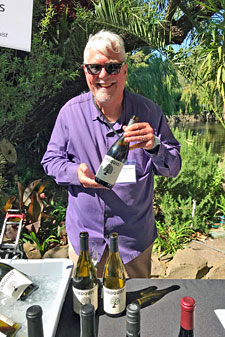 |
| Bob Lindquist |
Bob Lindquist was one of the earliest of California’s “Rhone Rangers,” and has been making wine on the Central Coast since 1982. In addition to the Lindquist Family Wines label, Bob’s wife Louisa has her own wine label, Verdad, and they work together on wines for their Sawyer Lindquist label. Bob was behind his winery table at the event. The 2021 Ibarra-Young Vineyard Marsanne, aged in neutral oak, displayed apple, earth, and spice aromas with medium weight and lively acidity – while pleasant now, this wine always benefits from extended aging. The 2021 Bien Nacido Hillside Roussanne had pear and stone fruit on the nose plus herbal undertones, with a richer mouthfeel and finish than the Marsanne. Next was the 2020 GSM, a blend of 52% Grenache, 24% Syrah, and 24% Mourvèdre, bottled under screwcap. This featured lots of upfront bright red fruit and spice, a vibrant mouthfeel, and fine tannins on the finish. The 2020 Bien Nacido Vineyard X Block Syrah “The Good Nacido”, from 50-year old vines, was dark-fruited with earth, smoke, spice, and a savory element on the nose, medium-full bodied with great structure for further development.
|
Long Walk Vineyard
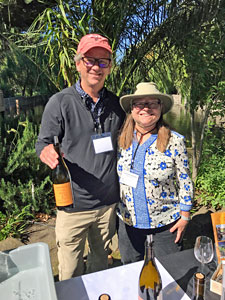 |
| Tim & Kathy O'Leary |
Tim and Kathy O'Leary are the proprietors of Long Walk Vineyard, located in the Rogue Valley of southern Oregon, near Ashland. Their 11-acre vineyard, planted about 20 years ago, includes Mourvèdre, Syrah, Grenache, Cinsaut, Carignane and Zinfandel. They also own nearby Valley View Orchard – both the vineyard and orchard are certified organic. I particularly enjoyed a couple of the wines that Tim and Kathy poured. The 2022 Rosé – 100% Cinsaut and made in stainless steel – featured super-bright red fruit and floral aromas, vibrant acidity, and a long, clean finish. The 2021 Carignane was a lighter and brighter rendition of this variety than most, with both red and black fruit, earth, and spice components, a lively texture, and moderate tannins.
Ridge Vineyards
 |
| David Gates |
The first Ridge wines, made by Dave Bennion, were from 1962, and Paul Draper led the winemaking from 1971 until just a few years ago. The Monte Bello estate vineyard, high in the hills above Cupertino, is the source for their famed “Monte Bello” wine as well as many others. John Olney now heads up the Ridge winemaking team, and longtime head of vineyard operations David Gates was on hand to pour the wines at the event. The 2022 Grenache Blanc, sourced from the Adelaida District of Paso Robles, is 86% Grenache Blanc and 14% Picpoul – this had bright stone fruit and floral aromas with hints of tropical fruit, medium-light weight on the palate and a clean, fresh finish. The 2022 Lytton Estate Rosé is 41% Grenache, 39% Zinfandel, 11% Cinsaut, and 9% Counoise, and was whole-cluster pressed and made entirely in stainless steel. It displayed upfront strawberry and floral notes, a lively texture, and long, tasty finish. My favorite at the Ridge table was the 2019 Gonsalves Mataro, sourced from Contra Costa County. Aged in older barrels, this was earthy and smoky, with black cherry and plum fruit and undertones of dried herbs and flowers, with good structure and moderate tannins.
Tablas Creek Vineyard
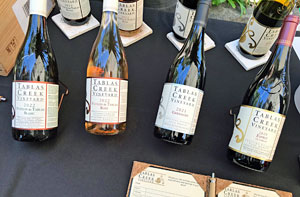 |
Founded in 1989, Tablas Creek is co-owned by the Perrin family (of Château de Beaucastel fame) and Haas family (of Vineyard Brands importers). Their 270-acre estate vineyard in the Adelaida District of Paso Robles was first planted in the early 1990s – it’s been certified organic since 2003 and more recently has received both biodynamic and regenerative organic farming certification. Jason Haas heads up the winery, while Neil Collins is the longtime winemaker there, and Jordan Lonborg is the viticulturist. The 2022 “Patelin de Tablas” Rosé – 67% Grenache, 21% Mourvèdre, 9% Counoise, 3% Vermentino – featured bright red fruit, flowers, and a touch of citrus on the nose, with medium-light weight and vibrant acidity on the finish. The 2021 Grenache was red-fruited with earth and spice in support, medium-bodied with the acidity and tannins lending it good structure for some mid-term aging. Though it wasn’t displayed on the table, I got a taste of the 2021 Counoise – bright and floral with raspberry fruit, fresh herbs, and a touch of spice, with a lively mouthfeel and finish. The flagship 2020 “Esprit de Tablas” is 40% Mourvèdre, 30% Grenache, 21% Syrah, 5% Counoise, 3% Vaccarèse, and 1% Cinsaut in this vintage. Earthy and smoky plum and darker berry fruit with spice and herbal undertones, this was medium-bodied with great structure.
Tercero Wines
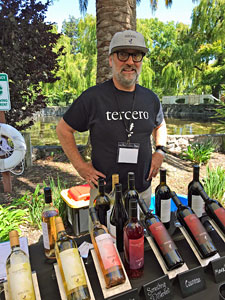 |
| Larry Schaffer |
Larry Schaffer started his Tercero label with the 2006 vintage while he was working for Fess Parker Winery – he’s focused on Tercero full-time since 2011. His specialty is wines from Rhône grape varieties, and he sources his fruit exclusively from Santa Barbara County vineyards. Larry was on hand to pour his wines at the event – he always has quite a few to taste so I picked a handful to try. The 2022 Picpoul Blanc, made entirely in stainless steel, featured bright lemon on the nose, lighter weight on the palate, and a zippy acidity and finish. The 2021 Mourvèdre Rosé was also made in stainless steel, and had earthy and bright red fruit and stone fruit plus fresh herb undertones, with a lively texture and finish. The 2021 Counoise was made entirely with foot-trod whole clusters and aged in neutral oak. It had upfront red fruit, spice, and floral aromas with vibrant acidity and a bit of tannic grip on the finish. The 2014 Mourvèdre (it’s the current release) was also fermented with whole clusters and aged in older barrels – it displayed the classic earth, smoke, dried herb, and plum aromas of this variety, with a lively medium-bodied mouthfeel and good structure.
The Grenachista Wine Company
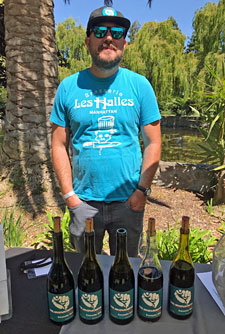 |
| Casey Graybehl |
Casey Graybehl launched his Grenachista label in 2013. His focus is exclusively on Grenache – both Blanc and Noir – and he works with vineyards in different parts of Northern California to produce a number of bottlings and styles of Grenache using low-intervention winemaking. I skipped some of the wines that Casey poured since I’d tasted them at the recent Garagiste Wine Festival tasting in Sonoma (the 2021 Cottonwood Vineyard Grenache Noir from Carneros that I tasted there was a standout) but I tasted two I hadn’t tried at that earlier event and both were very good. The 2021 North Coast Grenache Noir, sourced from four vineyards and meant for early drinking, displayed bright red fruit with floral undertones, a light and lively texture and mild tannins. The 2021 Alder Springs Vineyard Grenache Noir is the first vintage from this vineyard for Grenachista, and was fermented entirely with whole clusters. This featured both red and black fruit, earth, and spice, with herbal notes on the nose, a medium-full texture on the palate, and firm tannins – plenty of potential for further development with time in the cellar.
Troon Vineyard
 |
| Craig Camp |
Located in southern Oregon’s Applegate Valley, Troon was founded in 1972 by Dick Troon. After the current owners purchased the winery and vineyard property in 2017, the 50-acre vineyard has been gradually replanted with about 20 grape varieties and has received both biodynamic and regenerative organic farming certifications. Garett Long is the director of agriculture and Nate Wall is the winemaker. General manager Craig Camp – who’s also the current president of the Rhone Rangers organization – heads up the team at Troon, and was behind the winery table at the tasting. The 2022 Kubli Bench Rosé was barrel-fermented and aged on the lees, and displayed earthy stone fruit and touches of strawberry and spice on the nose, with good acidity and a medium-light weight on the palate. Next was the 2022 “Glou Glou” Grenache, made with partial carbonic fermentation. With loads of upfront bright red fruit along with earth and herb notes, this opened up and gained more aromatic layers with a bit of air, and it had a medium-light mouthfeel and a vibrant finish. I finished with the 2020 Syrah, which featured dark berry fruit, pepper, earth, and smoke aromas, medium-full body, and good structure for cellaring.
William Chris Vineyards / Lost Draw Cellars
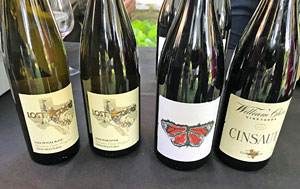 |
William Chris was established in 2008 by William "Bill" Blackmon and Chris Brundrett in the Texas Hill Country wine region. Sister winery Lost Draw was founded in 2012 by winemaker Andrew Sides along with his uncle Andy Timmons and father-in-law Troy Ottmers. Both labels work exclusively with Texas-grown fruit for their wines. The Lost Draw Timmons Estate Vineyard 2022 Picpoul Blanc, from the Texas High Plains wine region, was made entirely in stainless steel and displayed bright apple and citrus fruit aromas with lighter body and vibrant acidity. The William Chris 2021 Cinsaut, also from the Texas High Plains, had earthy red fruit with floral and spice undertones, medium-light weight on the palate with a lively texture and fairly mild tannins. The William Chris 2020 “Artist Blend” is 35% Syrah, 33% Grenache, 30% Mourvèdre, 2% Tannat, all from Vintage Press Vineyard in Texas Hill Country. This had a bolder and darker fruit profile, with plenty of spice and notes of earth and dried herbs, medium-full bodied with good structure and firmer tannins. |


